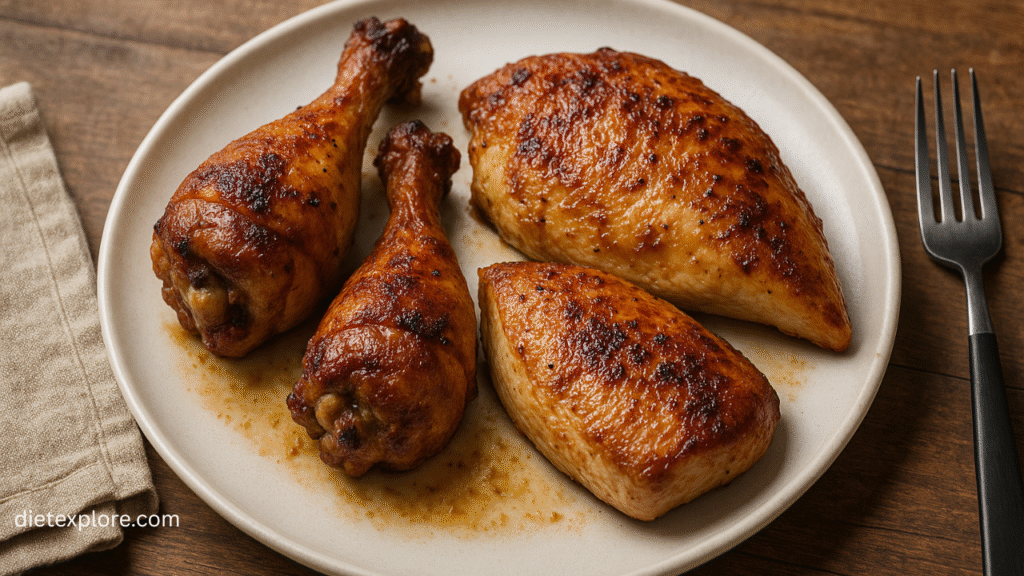Dark Meat Chicken
Dark meat chicken refers to the legs, thighs, and wings of the bird, known for their richer flavor, juicier texture, and darker color compared to white meat. These cuts come from muscles that are more active, leading to higher myoglobin content, which gives them their characteristic dark hue.
Dark meat is popular in many cuisines worldwide due to its tenderness and depth of flavor. It’s often preferred for grilling, roasting, and slow-cooking methods because it stays moist even when cooked for longer periods.
According to the USDA, dark meat accounts for about 30% of a chicken’s total weight, making it a significant portion of the bird. It’s also more affordable than white meat in many markets, making it a cost-effective protein source.
What Is Dark Meat Chicken?
Dark meat chicken comes from the legs (drumsticks and thighs) and wings of the bird. Unlike white meat, which comes from the breast and tenderloins, dark meat contains more myoglobin, a protein that stores oxygen in muscles. This higher myoglobin content gives dark meat its darker color and richer taste.

Key characteristics of dark meat:
- Higher fat content (about 5-7% fat compared to 3% in white meat)
- More connective tissue, making it ideal for slow cooking
- Rich, savory flavor due to increased collagen and fat
A study by the Journal of Food Science found that dark meat retains more moisture during cooking, making it less likely to dry out than white meat. This makes it a favorite for dishes like stews, curries, and barbecued chicken.
Also Read: /yogurt-drink/
White Meat vs. Dark Meat Chicken
The debate between white and dark meat chicken often comes down to texture, taste, and nutritional differences.
| Aspect | White Meat (Breast) | Dark Meat (Thighs/Legs) |
|---|---|---|
| Color | Pale pink/white | Darker reddish-brown |
| Texture | Lean, tender | Juicy, slightly firmer |
| Flavor | Mild | Rich, savory |
| Fat Content | 3% | 5-7% |
| Best For | Grilling, baking | Slow cooking, frying |
According to Harvard Health, dark meat contains more iron and zinc than white meat, making it beneficial for immune function and energy levels. However, white meat is lower in calories and fat, which may be preferable for those on a low-fat diet.
White Meat vs. Dark Meat Chicken Pieces
When choosing between white and dark meat pieces, consider their best culinary uses:
- Chicken Breast (White Meat):
- Best for grilling, baking, or pan-searing
- Lower in fat but can dry out if overcooked
- Ideal for salads, sandwiches, and healthy meals
- Chicken Thighs & Drumsticks (Dark Meat):
- Perfect for braising, roasting, or frying
- Stays juicy even at higher temperatures
- Great for curries, stews, and comfort foods
A USDA report states that dark meat pieces are often more affordable due to higher demand for white meat in diet-conscious markets.
Dark Meat Chicken Recipes
Dark meat is incredibly versatile. Here are some delicious ways to prepare it:
1. Classic Roasted Chicken Thighs
- Marinate thighs in olive oil, garlic, rosemary, and lemon.
- Roast at 375°F (190°C) for 35-40 minutes until crispy.
2. Spicy Braised Drumsticks
- Sear drumsticks, then simmer in a tomato-chili sauce for 1 hour.
3. Thai Coconut Chicken Curry
- Cook thighs in coconut milk, red curry paste, and vegetables.
These recipes highlight dark meat’s ability to absorb flavors and stay tender.

Is Dark Meat Chicken Healthy?
Yes, dark meat is nutrient-dense and offers several health benefits:
- Higher in iron and zinc than white meat (per USDA data)
- Contains more B vitamins, especially B6 and B12
- Provides healthy fats that support brain function
A study in The American Journal of Clinical Nutrition found that moderate consumption of dark meat does not negatively impact heart health.
Is Dark Meat Chicken Bad for You?
While dark meat is nutritious, some considerations include:
- Higher calorie and fat content (about 50-70 more calories per serving than white meat)
- May not suit very low-fat diets
However, the Harvard School of Public Health states that the fats in dark meat are mostly unsaturated, which are heart-healthy.
How to Cook Dark Meat Chicken
Dark meat is forgiving and hard to overcook. Best methods:
- Roasting (crispy skin, juicy inside)
- Slow cooking (breaks down collagen for tenderness)
- Grilling (enhances smoky flavor)
Internal temperature should reach 165°F (74°C) for safety (per FDA guidelines).
Calories in Dark Meat Chicken
Here’s a comparison per 100g (cooked, skinless):
| Cut | Calories | Protein | Fat |
|---|---|---|---|
| Chicken Thigh | 209 kcal | 26g | 10g |
| Chicken Leg | 184 kcal | 24g | 8g |
(Source: USDA Food Database)
Conclusion
It is flavorful, nutritious, and versatile. While slightly higher in fat than white meat, it provides essential nutrients like iron and zinc. Whether roasted, grilled, or braised, dark meat remains juicy and delicious.




